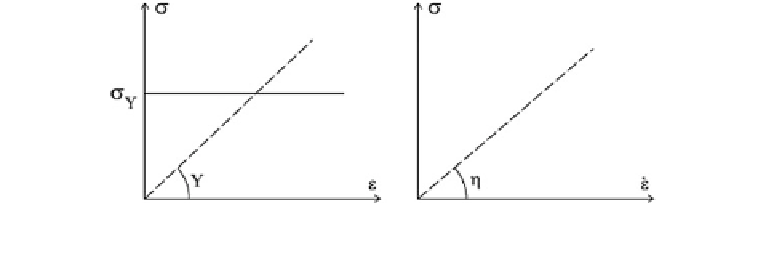Geoscience Reference
In-Depth Information
Fig. 5.4
The basic rheology models (in one dimension) for the stress
σ
as a function of the strain
ʵ
and the strain-rate
e
; E is elastic modulus,
ʷ
is viscosity, and
σ
Y
is yield strength
dimensional cases are illustrated in Fig.
5.4
. The linear elastic model assumes that stress is
proportional to strain, while in the linear viscous model stress is proportional to the strain-
rate; the proportionality coef
s
modulus) and viscosity. Rubber and water
1
are good material examples of linear elastic
and viscous media. An ideal plastic medium collapses once the stress achieves yield
strength (children
cients are, respectively, the elastic modulus (or Young
'
s modelling wax serves as an example of a plastic medium).
Mechanical analogues for these models include spring balance for linear elasticity,
dashpot
2
for linear viscosity, and static friction for plasticity.
The behaviour of a one-dimensional linear elastic beam is determined by Young
'
'
s
modulus E:
r
¼ E
e
ð
5
:
4
Þ
s modulus appears as the slope angle in Fig.
5.5
. For an isotropic three-
(or two-) dimensional case, one additional parameter is required for shear. Usually this is
treated using the Poisson
Thus Young
'
ʵ
xx
is
seen in the loading direction but contraction appears in the perpendicular directions, and
the Poisson
'
s ratio
ʼ
. For a beam in uniaxial (x) tension, tensile strain
'
is: ratio is:
e
yy
e
xx
¼
e
zz
e
xx
l
¼
ð
5
:
5
Þ
Once Young
'
s modulus and Poisson
'
s ratio are known, the bulk modulus K and the
shear modulus G are obtained as:
E
3
ð
1
2
lÞ
;
G ¼
E
2
ð
1
þ lÞ
ð
:
Þ
K ¼
5
6
Linear elastic rheology is written in three-dimensional form as
1
In laminar flow; in turbulent flow stresses are properties of the flow, not properties of the medium.
2
Such as a door stroke compressor, which dampens or softens the movements of a door.





Search WWH ::

Custom Search